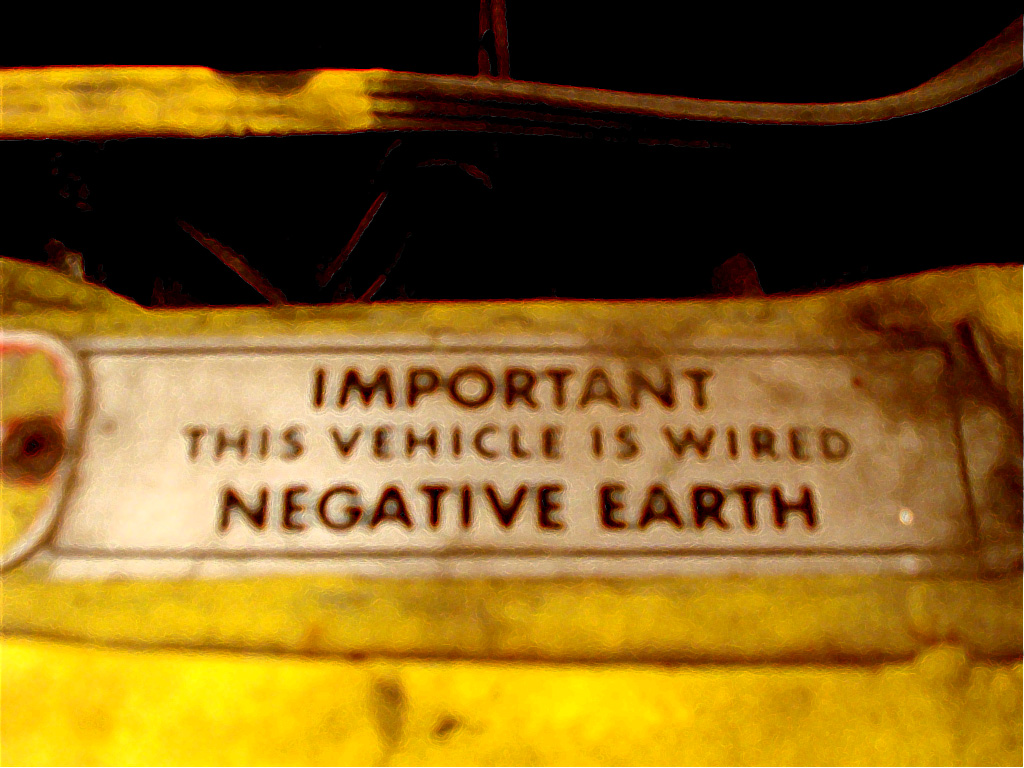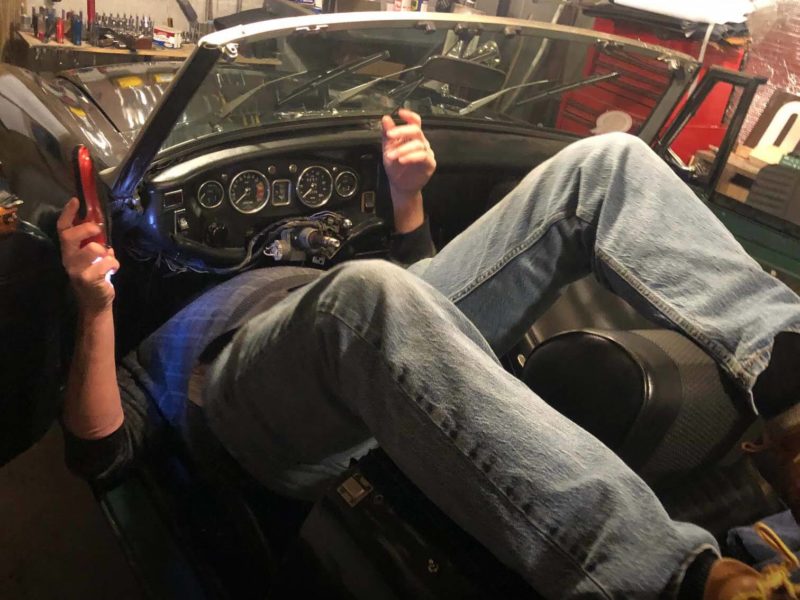If your British car was built before 1968, it probably is wired for positive earth. That is not some kind of sixties hippie movement, but rather the practice of connecting the plus terminal of the car’s battery to the chassis as common ground. It was once thought by the English that there was a scientific advantage to using this arrangement in automotive DC electrical wiring. By the time automobile generators were replaced by alternators, carmakers all over the world were connecting the minus battery terminal to the car’s body making negative the ground for the electrical system. I am sure this was done just to make Joe Lucas look bad!
All this ground (a.k.a. earth) business goes back to the way the wiring in your house works. Even though it is alternating current, one side of the dynamo at the power station is actually connected to a metal rod buried in the dirt. That is why you can electrocute yourself by getting across a hot wire and a conductor that is touching the ground beneath your feet! The telephone company does the same thing, and you can check for the hot side of a telephone line by connecting your phone from a ground source to one side of the line and listening for dial tone. No, I don’t know why anyone would want to do this.
The reason for bringing up all this fascinating stuff is that often times we would like to add a modern sound system, or other such electrical gadget to our favorite ride, and all that new stuff requires negative ground. On a really old car, just about all you have to do is swap the cables on the battery to change from positive to negative ground. Most electrical devices found on early British vehicles are not polarity sensitive. The gas gauge, fuel gauge, generator, voltage regulator, fuel pump, wiper motor, heater motor, turn signal flasher, lights and starter will all function normally regardless of the polarity.
The coil will still work, but does in fact have the preferred polarity marked on the terminals. Newer models will be marked plus and minus, while older ones will have “SW” and “CB” instead. The “SW” refers to the ignition switch and “CB” is for the distributor contact breaker, i.e. points. With the original arrangement, the ignition switch would be supplying negative battery and the contact breaker would be connected to positive earth. Therefore, when converting to negative ground, reverse the wires on the coil so that negative (the black and white wire from the distributor to the coil) is now on the “SW” or “-”,and positive (white wire from the ignition switch) is now connected to “CB” or “+“. There is also an urban legend about the need to “polarize your generator” when converting to negative ground. I follow the repair manual instructions when I do the swap, but am somewhat skeptical as to the need for it!
Electric tachometers were introduced on some vehicles before the change to negative earth, but can be modified to work that way. Just Google it! Of course, the amp meter will read backwards, but just reverse the wires and presto, change-o! Newer electric fuel pumps are also polarity sensitive, and will have to be replaced with the correct model.
Modern solid state flasher units have to be negative ground also, and won’t work in a positive ground car.
Those wonderful Pertronix Ignitor electronic ignition modules can be ordered either positive or negative, but the positive earth version is often more expensive and the wiring is not as straight forward.
Some electric radiator fans that push or pull depending on polarity must be wired for negative ground, because running the “wrong” direction will ruin the bearings. These things suck so much juice, that you will probably need an alternator (always negative ground) to keep it from burning up the generator or running the battery down.
Personally, I don’t find that electric radiator fans are particularly effective and I don’t recommend alternator conversions either…for a couple of obscure reasons that I might have a hard time defending!
By Mike McPhail
Gulf Coast Austin-Healey Club
Hill Country Triumph Club









'Pint Size Project — Positive Earth?' have 8 comments
October 12, 2012 @ 10:29 am David DuBois
I would like to add something to Mike’s excellent article on electrical polarity. The picture that he included is something that should be added to any British car from the 60s. If your car is positive ground and you opt to keep it that way, purchase a couple of “This Vehicle is Wired POSITIVE Earth” stickers (available from Moss Motors) and put one on the slam panel under the bonnet and another one near the battery itself. This could well save you a destroyed battery if you ever have to have a service organization (such as AAA) come out and jump start your car, or have the battery replaced by a local garage and wind up with connections being made for the wrong polarity. Conversely, if you change the polarity of an early British car to negative ground, get some stickers stating that “This Vehicle is Wired NEGATIVE Earth” on it to prevent a more knowledgeable mechanic from attaching the battery in a positive earth configuration because, “He knows that early British vehicles are all Positive earth.” (Interestingly, prewar British vehicles were wired negative earth – it was only a relatively short period of time that the Brits went with positive earth.)
Cheers,
Dave
October 30, 2012 @ 9:47 am mark Zemke
Don’t know about all British prewar vehicles but a 1936 Rolls 25-30 I work on is wired Neg Earth
Ford in the USA did not change over to Neg Earth untill 1956, I’ve read somewhere the reason to use Neg Earth is that Battery construction/plate chemistry/physics allows more energy to be drawn using the Pos term .
January 1, 2013 @ 1:21 pm gerard crompton
why not a nalternator on say a tr3?
July 5, 2013 @ 10:38 am Art Liefke
How can you say that “I don’t find that electric radiator fans are particularly effective” when they have been put on virtually every car for the past 20 or so years in lieu of engine driven fans?? I have one (electric fan) on my TR3 as my only fan and it keeps the temps in check just fine. Yes, i also have an alternator.
July 26, 2013 @ 1:09 pm Don Stenton
Your absolutely right… “electrical devices are not polarity sensitive. The gas gauge, fuel gauge, generator, voltage regulator, fuel pump, wiper motor, heater motor, turn signal flasher, lights and starter will all function normally”. BUT, you forgot to include that most British cars came with AMMETERS. If you don’t mind the needle reading a negative voltage when charging, then don’t change to polarity of the meter!
Regarding the “urban legend”, the polarization process is simple. Disconnect the fan belt, turn on the ignition and momentarily close the contacts on the right hand coil, the one that goes to the battery. The generator is now polarized for negative ground.
April 22, 2016 @ 7:47 pm John Holton
In my garage, everything electrical on my AH3000 MK1 required for DE inspection worked. At DMV, brake and rear running lights, license plate light and left headlight hi and lo did not work! Back in garage, everything except headlight hi and low worked. Fuses looked good but test lighted them to engine block. No light. Used jumper cable to test them to battery, light! what has the P>O>D> done to me?
November 13, 2017 @ 12:52 pm Neil
Just a reminder, if you have LED lamps fitted, these are polarity sensitive and will have to have their wires swapped in order to work at all. Also retro fitted flasher units will have to have their wiring altered.
April 4, 2021 @ 7:05 pm Paul45
I’m no mechanic and definitely no electrician but hope to own a 67 Healey 3000 soon. A battery has two posts, a negative which is normally a smaller post and a positive which is normally a larger post, if the wire from the larger post, positive is connected to the body or ground then the car is positive ground or earth and vice versa if the larger post is connected to the starter motor then it is normal for todays cars, positive is positive and negative is ground or earth.